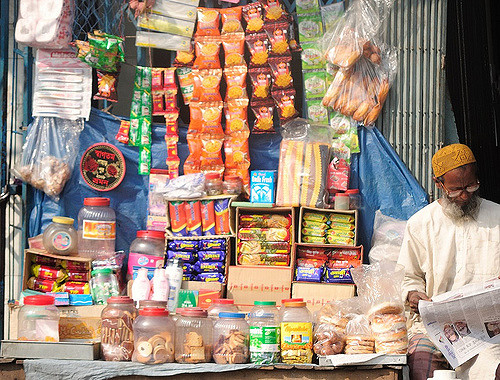The Art of Persistence Posted by Rachael on May 11, 2018 in Uncategorized
As you continue learning Hindi, hopefully you are coming to appreciate how streamlined the grammatical system is, especially when compared to the disorganized, exception-ridden behemoth of a language that is English. Luckily for learners, Hindi has a relatively straightforward grammar based on that of its parent language, Sanskrit, which has a more complicated, yet still relentlessly logical, grammar. This week, let’s dive into another grammatical concept that will prove immensely useful to you in your Hindi conversations and/or forays into reading in Hindi: करता रहना or जाना/kartaa rehnaa/jaanaa (to keep/go on doing).
Now, these are two distinct concepts that I would like to keep separate initially, for clarity’s sake. The first concept is करता रहना/kartaa rehnaa/to keep on doing. Basically, the rule is that you can use almost any verb in the first position (in this one we have करता/kartaa from the infinitive verb करना/karnaa=to do), but you must conjugate it in the imperfective participle and change it according to the number and gender of your subject. The next rule is that रहना/rehna (to be, live, stay) must come afterwards and must be conjugated to agree in number and gender with your subject and also with the primary tense of your sentence. This is how you express the sentiment “to keep on X-ing.” Be patient, illumination may come with a few examples:
- हम लोग सारे हफ़्ते अखबार पर काम करते रहे लेकिन, अंत में, काम पूरा नहीं हुआ । (Hum log saare hafte akhbaar par kaam karte rahe lekin, ant me, kaam poora nahin huaa). We kept working all week (long) on the newspaper but, in the end, the work wasn’t finished.
- इतनी गर्मी है आज कि मैं नींबू वाला पानी पीती रहूँगी । (Itnee garmi hai aaj ki main neembu vala paani peetee rahoongi). It’s so hot today that I’m going to keep drinking lemon/lime water.
- अगर दिन भर धूप में तुम दौड़ते रहोगे, तो थक जाओगे । (Agar din bhar dhoop me tum daurte rahoge, to thak jaaoge). If you keep running all day in the sun, you’ll get tired.
Thus, you can see that you must have a verb in the first position that is conjugated as an imperfective participle and agrees with the number and gender of the subject. Then, you must have the verb रहना/rehnaa in the second position, conjugated to agree with the subject in gender and number and also to reflect the actual tense of the sentence (which might be future, past, etc.). As in these explanations from the above examples:
- हम लोग (masc. plural, in this case) + काम करते (conjugated to agree with masc. plural) + रहे (masc. plural, simple past tense).
- मैं (fem. singular, in this case) + पीती (conjugated to agree with fem. singular) + रहूँगी (fem. singular, future tense).
- तुम (masc. plural, in this case; “tum” is always grammatically plural, even if you only mean ONE “you”) + दौड़ते (conjugated to agree with masc. plural) + रहोगे (masc. plural, future tense).
The cool thing about this construction is that the initial verb will always be in the same tense (this is its default tense in order to complete the construction), it will just change to reflect the gender and number of your subject. So, काम करता never becomes काम किया or काम करेगा, etc. रहना is the only verb that changes tense.
Now for जाना/jaanaa (to go)! This construction is very similar to the one with रहना/rehnaa and you will often see the two used interchangeably as speakers often aren’t overly concerned with grammatical correctness (who is, anyway)? But, if you want to know the fine differences, sentences with जाना/jaanaa (to go on doing X) indicate a building up or progression to a completion or culmination, at which activity would logically have to cease.
- उसको इतनी भूख लग रही थी कि पराठे खाता जा रहा था । (Usko itni bhook lag rahi thi ki paraathe khaataa jaa rahaa thaa). He was so hungry that he kept on eating parathas. (The implication is that, as this person continues to eat progressively more and more parathe, there will be a limit to his hunger and he will have to stop).
- अध्यापक जी बच्चों में बिस्कुट बाँटते गये । (Adhyaapak ji bacchon me biscuit baantate gaye). The teacher went on/kept on distributing cookies amongst the children. (The implication is that, as the teacher keeps distributing cookies amongst the children, piece by piece, there will be an end point where he runs out of cookies).
- कमला कविताएँ लिखती जायेगी लेकिन, फिर भी, उसकी बातें किसी की समझ में कभी नहीं आयेंगी । (Kamala kavitaae likhti jaayegi lekin, phir bhi, uski baaten kisi ki samajh me kabhi nahin aayegi). Kamala will go on writing poems but, even so, no one will ever understand her sentiments. (The implication is that Kamala will keep/go on writing poems, one by one, until she stops because of death, loss of creativity or maybe even frustration with her unappreciative readers).
Thus, hopefully you can see that जाना/jaanaa deals with actions that are more easily quantifiable and/or tangible (or actions that occur in stages, step by step) and has the implication of an end point, whereas रहना/rehnaa is more intangible and unquantifiable and doesn’t necessarily suggest an end point.

Build vocabulary, practice pronunciation, and more with Transparent Language Online. Available anytime, anywhere, on any device.







Comments:
Ian Rowcliffe:
Hi Rachael
Just wondering if this reflects the true pronunciation or is just a typo:
You wrote: अध्यापक जी बच्चों में बिस्कुट बाँटते गये । (Adhyaapak ji bacchon me biscuit baatate gaye) The transliteration should be: adhyaapak jee bachchon mein biskut baantate gaye. I mention this because I often can’t hear nasalisation, even wondering if it is there at all in certain instances? Thanks, Ian
Rachael:
@Ian Rowcliffe Hi Ian,
thank you for catching that! Yes, that verb is nasalized, just as you said. It should be transliterated “baantate.” Personally, I don’t like English transliterations of Hindi because the English alphabet (without special symbols) can’t accurately convey Hindi pronunciation so, if you’re ever in doubt, just look at the Hindi text instead. Thank you again for catching it! A good practice for nasalization would be the words हंस (swan) and हँस(ना) (laugh). The former has an “n” sound, which is related to a pure nasalization, but not quite the same thing; so you can actually hear the “n” sound when someone says it. The latter is nasalized, so there is no pronounced “n” sound as such, it’s just that the air when you’re speaking flows through your nose. There are other pairings like that you can practice with. Though I would say that people do not always pronounce words as they are written, even in Hindi––people will shorten and/or muddy pronunciation of certain words just because it’s easier, just as we do in English.
Rachael
Ian Rowcliffe:
@Rachael Ha, ha: I am thinking of a laughing swan – interestingly the ‘honk’ type of noise the bird makes IS a nasalised sound. All to say, what an insight! Thanks: great work!
Rachael:
@Ian Rowcliffe Hi Ian,
thanks, glad you liked it! Just a small note as I saw your other comment—Google Translate still has to come a LONG way before it can translate Hindi and Urdu accurately (and most other South Asian languages, for that matter). I highly recommend U of Chicago’s dsal dictionaries for Hindi and Urdu. You can access them here: http://dsal.uchicago.edu/dictionaries/. They are from Hindi and Urdu to English, however, and not the other way around. But, a pretty good dictionary from English to Hindi is Oxford’s “English-English-Hindi Dictionary.”
Ian Rowcliffe:
@Rachael Thanks for the tip – by the way, it would be helpful if readers had a way of being informed when comments are commented on.
Sometime back, I think you asked readers to suggest themes for posts. Well, more on conversational Hindi would be helpful – I only found the one on the weather. I was thinking of a Hindi version of ‘100 Answers To Common English Questions’ – actually there are 20 recorded questions with 5 answers each. Keep up the good work and thanks again.
Rachael:
@Rachael Hi Tristian,
I’d be happy to answer any questions about my blogs. Just let me know what your questions are, and I’ll try to answer them 🙂